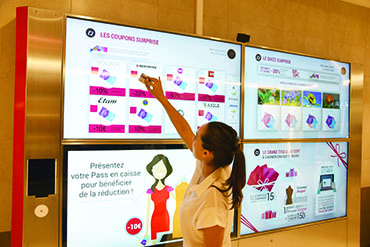Unification nation: Taking retail beyond the omnichannel approach
March 6, 2019
Unified commerce transforming the retail customer experience
BY JESSE DONALDSON
PICTURE this:
A customer walks through a retailer’s front door. They’ve come for a click-and-collect item they purchased on their laptop 24 hours earlier. Before they leave the store, they spend a few minutes browsing (simultaneously comparing prices on the ever-ubiquitous Amazon), and as they pass relevant items, the store’s smartphone app displays in-store deals that correspond to both their location, and their buying habits. They pick up a few more products—some of which they purchase, some they leave behind. At the checkout, they seamlessly combine a physical purchase with a digital purchase. As they make their way to the parking lot, their social media feed shows an ad for one of the items they left behind, along with a coupon for 15 per cent off, which, when clicked, allows them to purchase the item in the store’s mobile app—alongside other related items—and have these delivered to their home.
“Customer expectations in retail are increasing, regardless of a retailer’s size, and to compete, winning retailers are adopting a unified commerce strategy.”
BRIAN BUNK, BRP Consulting
The modern consumer is more connected, and expects more flexibility than ever before. Robert Hetu, a Research Director with Retail Service firm Gartner, says that in today’s marketplace, delivering experiences like this are more important than ever before. For today’s retailer, eCommerce alone is no longer a competitive advantage; the key to continued success lies in transforming the omnichannel and multichannel approaches of the past into a seamless unified commerce strategy—one that can deliver a consistent experience, regardless of a customer’s purchase journey.
“Oftentimes, a customer may be shopping in multiple channels at one time,” he notes. “They might be in your store and on your website through their mobile device. They may be on your mobile app and your eCommerce site at the same time. So, the idea is that customers need to be able to flow very freely from one experience to the next. It’s about starting with the consumer, and creating an environment where they can browse, transact, acquire, and consume products independently of channel. In reality, within each retailer, there are channels, and the number of channels is growing pretty dramatically. But from the perspective of the customer, they really don’t want to see any difference.”
“Customer expectations in retail are increasing, regardless of a retailer’s size,” adds Brian Bunk, Principal at BRP Consulting, “and to compete, winning retailers are adopting a unified commerce strategy. The benefits are numerous: improved customer experience, increasing expectations, simplified and agile technology, cross-channel inventory visibility and availability, flexible ordering and delivery options, personalization… And most of these benefits are becoming tablestakes in today’s competitive retail market.”
Omnichannel 2.0
According to Gartner’s 2017 primer on the topic, unified commerce is a strategy which leverages the “harmonious integration of retail processes/ systems to provide full transparency on the back end and seamless customer experiences on the front end.” Practically speaking, it is an evolution of the omnichannel approach of the past, one which allows a customer to start or stop their purchase journey at any point, and across any platform— be it their laptop, a mobile device, in-store, or any combination therein. It can involve digital assistants and cross-channel marketing, social media activity, and increased personalization. It integrates common POS systems with purchase processing, customer data, supply chain management, and eCommerce. It’s a lot to manage at once, Bunk admits—but it’s a feat made possible through the use of an accessible, cloud-based commerce platform.
“…we’re asking how the customer wants to shop, and enabling it to be a very consistent process, regardless of how that content is delivered.”
ROBERT HETU
Gartner
“The idea of a common, cloud-based, real-time commerce platform for all customer engagement points is a key tenet of unified commerce,” he says. “A unified commerce platform combines POS, mobile, web, order management, call centre and clienteling into one common integrated platform, which enables a holistic and seamless customer experience no matter how, when or where they shop with a retailer.”
And, Bunk adds, having the right technology in place can transform the customer experience even behind the scenes, through providing up-to-themoment inventory management, targeted recommendations based on data, and allowing for more nimble supply chains.
“Unified commerce not only offers a unified view of customer and inventory data, but also offers retailers the ability to provide ‘endless aisle’ capabilities and the ability to ‘save the sale’ by selling merchandise from – or to – any channels,” he says. “Cross-channel inventory availability can reduce inventory management costs and enhance customer service by giving customers further purchasing options.”
But, as Hetu points out, it isn’t all about the technology. In fact, the first step is a change in approach, to restructure the business processes of yesteryear, and put the customer firmly in the driver’s seat. The successful retailers of tomorrow, he argues, will be the ones who centre their strategy around four major customer practices: browsing, transaction, acquisition, and consumption. Whether it’s using IoT-enabled devices or mobile apps (or even AI) to help customers find what they need, having interconnected POS systems that seamlessly allow for transactions across all channels, facilitating multiple pick-up and delivery options, creating an endless aisle, or allowing for automated replenishment, the key is to focus on the customer needs, and build outward.
“Take browsing, for example,” Hetu says. “Customers always browse. They may start their browsing online, or in-store, or on their mobile device. They may start it on Amazon, and then move to your site. They browse in a variety of ways. If we think about browsing for products, it starts to cause us to think: ‘Maybe we should have an organization that’s designed around browsing, rather than putting different departments in charge of the assortment online, or the assortment in-store. Instead, we’re asking how the customer wants to shop, and enabling it to be a very consistent process, regardless of how that content is delivered.”
United We Stand
Hetu admits that it won’t necessarily be easy. Not only does a move toward Unified Commerce require an investment in technology, but also demands a change in thinking, one that moves away from a traditional, siloed approach to retail, and will demand as much integration behind-the-scenes as it does on the front end.
“Oftentimes, business processes are still very disconnected,” he says. “You’ve got siloes within the retail organization, and those business processes start to interfere in that kind of environment. So, the processes themselves have to be reorganized. That’s why we’re so focused on this idea of structuring both the applications and the business processes around the customer’s process.”
And when it comes to the customer process, there is no better way to start than by leveraging data. Today, there are more ways to collect information than ever before; not only when it comes to online buying habits, but in-store. Mobile apps, RFID tags, and even computer vision can give modern retailers an unprecedented look not only at what their customers buy, but at what they pick up, carry around, and even leave behind. Some major retailers are already using AI, IoT, and predictive analytics to improve that process further still, allowing them to respond to customer needs on a virtually granular level, taking into account factors like the weather, previous demand, and IoT sensor data to create incredibly nimble supply-chains and vastly improve inventory management. And while much of the growth in the unified commerce arena is taking place amongst major U.S. retailers, Hetu is quick to note that Canada—sometimes seen as a laggard in the digital sphere—isn’t far behind.
Unified commerce is a strategy which leverages the “harmonious integration of retail processes/systems to provide full transparency on the back end and seamless customer experiences on the front end.
Gartner
“There are definitely things happening in Canada,” he says. “There are some retailers in Canada that have done some very interesting things—and will continue to. Loblaw’s has done a lot of work with the customer experience. You see companies like Sobey’s, which is starting to experiment with different formats. In fact, I’d argue that if you look back a few years, to Target’s failure in Canada, it’s in part because Target underestimated the sophistication of the Canadian market.”
And, as both Bunk and Hetu point out, a cohesive unified commerce strategy isn’t just for the big retailers. Not only will the large-scale changes required be simpler for small and mid-size businesses, but those same businesses could also run the greatest risk of being left behind. With consumer expectations constantly evolving, and retailers competing for ever-moreelaborate ways of enhancing the customer experience, Bunk argues that the time for unified commerce is now.
“The store of the future will require a personal, mobile, relevant, ubiquitous and secure environment to meet rising customer expectations,” he explains. “Retailers need to operate in real-time, with customer and product information accessible across the enterprise—this necessitates cloud-based applications and a reliable, responsive network. Defining what you want your customer experience to be is key. Having the journey defined allows a retailer to deliver components of the journey based on business value and impact. Developing these components using modern technology and with a holistic view will allow the successful retailer of tomorrow to adapt as consumer expectations continue to evolve.”

